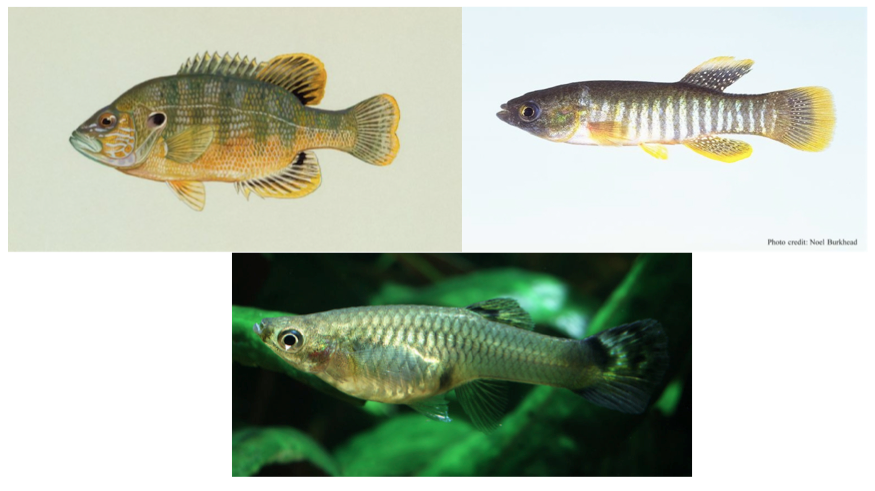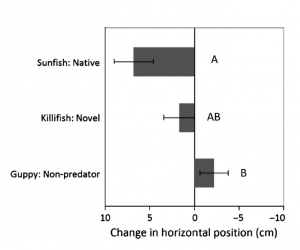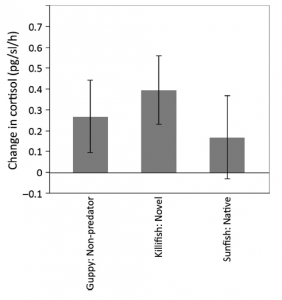You’re walking down the street and suddenly come face to face with a creature you’ve never seen before. It’s doesn’t look (or smell) like anything you ever remember learning about. How do you react? Is this creature friend or foe? While this situation is very unlikely for humans, it is becoming a reality for more and more animals. Human activities are leading to the introduction of new species into different environments, and native prey species may not be able to accurately assess the risks and respond. Most interactions between species, especially between predator and prey, depend on knowledge and recognition of each other. If a prey species has never encountered a particular predator before, they may not be able to appropriately respond and survive when these interactions occur.
Typical responses to predators include both behavioral and physiological responses. In terms of behavior, the prey should move away from the predator once it is sensed. Physiologically, elevation of stress hormones can help can make responses quicker and more pronounced. Fish in particular release cortisol in response to stressful situations. Fish can also have both innate and learned responses when it comes to their anti-predator behaviors: They sometimes recognize unfamiliar predators through chemicals emitted in the water, but can also respond to different predators that look similar to each other, even if one is unknown. However, these abilities depend on the prey and predator fish involved.
A recent study published in Ethology by Chelsea A. Blake et al. looked at how a particular fish responded to the introduction of a novel predator. The researchers studied the Largespring mosquitofish, Gambusia geiseri, and tested both its behavioral and physiological responses to three potential predators. The potential predators used were: the native predatory Green sunfish, the novel predatory Gulf killifish, and the non-predatory guppy. The Gulf killifish was chosen because it looks different than the Green sunfish, but it the same size. They recorded the responses to both visual and chemical cues from the potential predators, and hypothesized that the Largespring mosquitofish would respond to the Green sunfish with changes in behavior and elevated stress hormones, but that it would not respond to the Gulf killifish or the guppy.

All pictures licensed under Public Domain via Wikimedia Commons. Top Left: “Green sunfish (Lepomis cyanellis)”. Drawing by Duane Raver. Source= Cropped from U.S. Fish and Wildlife Service Digital Library System. Top Right: “Fundulus grandis”. http://commons.wikimedia.org/wiki/File:Fundulus_ grandis.jpg#/media/File:Fundulus_grandis.jpg. Bottom: “Female Guppy” Photo by H. Krisp.
To set up the experiment, Largespring mosquitofish and Green sunfish were caught from the same lake, while Gulf killifish were collected from a separate river and guppies were taken from stock populations. Consistent concentrations of chemical cues from the potential predators were sampled from the water to be used later in the experiment. A focal Largespring mosquitofish was placed in a tank with two other shoal mates, and one-way tinting was applied so that the predators could not see the prey. An opaque barrier was also placed on the side of the tank until the predator stimulus was introduced. Then, a single predator being tested was placed in a tank adjacent to the prey tank and all fish were allowed to settle overnight. Prior to testing, hormone levels (cortisol) of the Largespring mosquitofish were taken, and their behavior was monitored and recorded. The behaviors of interest were movement horizontally or vertically in the tank. This information served as the baseline so that any changes could be recognized.
To begin the test, researchers introduced the previously collected predator chemical cues as they removed the opaque barrier from the tank. This allowed the Largespring mosquitofish to be exposed to the predator species both chemically and visually at the same time. Behavioral response to the predator was once again recorded for 5 minutes, and then hormone levels were tested again. The focal individual was then returned to its tank, and the procedure was repeated the following two days for the other predator species.
After analyzing the data, the researchers were surprised with the results. The prey did alter their behavior by moving away from the visual and chemical stimulus of the native predator (Fig. 1), but did not change their vertical position in the tank or increase their levels of the stress hormone cortisol (Fig 3). They concluded that the change in behavior in response to the native but not the novel predators indicates that the Largespring mosquitofish failed to accurately assess the risk of predation by the Green sunfish. Their results also support the idea that anti-predator behavior might not always be paired with a hormonal stress response.

Fig. 1: Behavioral response of Largespring mosquitofish to three stimulus species. Change in horizontal position (post-pre +/- SE) differs among treatments. Letters indicate significant difference from Tukay’s post hoc comparison.

Fig. 3: Hormonal response of Largespring mosquitofish to three stimulus species. Change in natural log of cortisol release rates (post-pre +/- SE) did not differ among treatments.
This experiment is significant because it shows that the introduction of novel predator species to new environments may have devastating effects on the already present species. Novel predators may be at an advantage because their prey cannot accurately recognize and respond to them as a threat. This could affect both the native prey and predator populations because novel prey could be more competitive. The entire food chain in place could be thrown off by the introduction of any new species, but predators may be even more disruptive. More work should be done to see how other species respond to novel predators, and populations of introduced fish should be closely monitored to ensure that native species are not decimated.
For more information you can read the full article:
Blake, C. A., Alberici da Barbiano, L., Guenther, J. E., & Gabor, C. R. (2015). Recognition and Response to Native and Novel Predators in the Largespring mosquitofish, Gambusia geiseri. Ethology, 121(3), 227-235.

